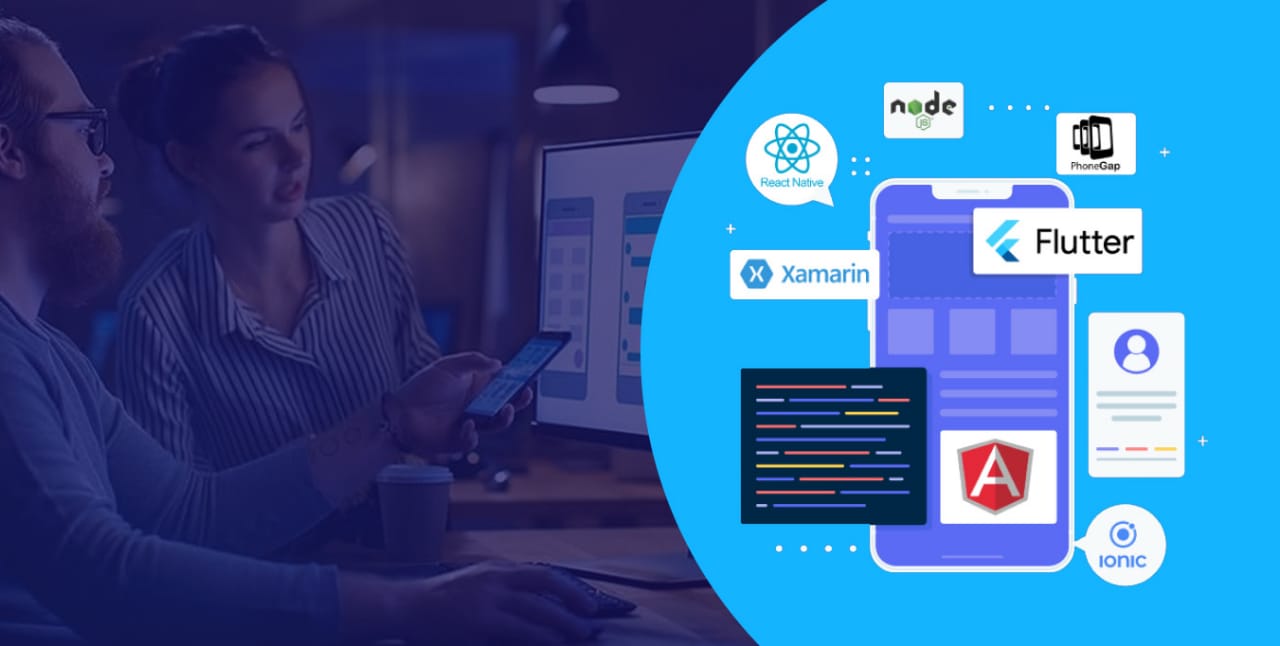In today’s fast-paced digital landscape, mobile applications have become an integral part of our lives. With the boost of smartphones and tablets, businesses and developers alike are constantly seeking efficient ways to create engaging and user-friendly apps that can run seamlessly across multiple platforms. This demand has led to the rise of cross platform app development frameworks, which offer developers the ability to write code once and deploy it across various platforms, saving time and resources.
The industry of multi-platform app development continues to evolve, with new frameworks emerging and existing ones evolving to meet the changing needs of developers and businesses.
Before we dive deep into the detail, let’s get to know what is a cross platform mobile application first?
What Is a Cross-Platform Mobile App?
A cross-platform mobile app is the one that is compatible with multiple operating systems, like iOS and Android, but is built using a single codebase. It ensures uniform functionality and design across different devices. Utilizing frameworks like React Native, Flutter, or Xamarin, developers write code once and deploy it across all platforms, reducing development time and costs.
Statistics indicate the growing prominence of cross-platform apps: in 2021, they accounted for 41% of all mobile apps developed. Their popularity is driven by factors such as faster time-to-market, wider reach, and easier maintenance.
In this blog post, we’ll take a deep dive into the 7 best cross platform app development frameworks of 2024. Our team of app and web developers in Dubai have curated this list, selecting the best cross-platforms app development frameworks, their features, capabilities, and why they stand out in the crowded market.
Best Cross-Platform App Development Frameworks of 2024
- React Native
React Native has been a dominant force in the industry of cross-platform app development for several years, and its popularity continues to grow in 2024. Developed by Facebook, React Native allows developers to build native-like mobile apps using JavaScript and React. With a large and active community, extensive documentation, and support for hot reloading, React Native offers developers a robust framework for building high-performance apps across iOS and Android platforms.
- Declarative UI: Easily create interactive UIs using React’s declarative syntax.
- Native Components: Access to native modules and components for platform-specific functionality.
- Community Support: Large community and ecosystem with numerous libraries and resources.
- Live Reload: Instantly see changes during development without recompiling.
- Third-party Integration: Seamless integration with third-party services and APIs.
- Flutter
Google’s Flutter has quickly gained traction since its release, offering developers a fast and expressive framework for building native apps for mobile, web, and desktop from a single codebase. Powered by the Dart programming language, Flutter provides a rich set of customizable widgets, a hot reload feature for quick iterations, and excellent performance. With Google’s backing and a growing community, Flutter has become a top choice for developers looking to create beautiful and responsive apps.
- Hot Reload: Instantly see changes in the app without restarting.
- Widgets: Rich set of customizable UI components for building beautiful interfaces.
- Performance: High-performance rendering engine for smooth animations and transitions.
- Dart Language: Simple and flexible language with strong typing and ahead-of-time compilation.
- Single Codebase: Build for iOS, Android, and web from a single codebase, reducing development time.
- Ionic
Ionic has been a popular choice for hybrid app development, leveraging web technologies such as HTML, CSS, and JavaScript to build cross-platform apps. In 2024, Ionic evolved with Ionic Framework 6, offering improved performance, a revamped UI component library, and enhanced support for PWAs (Progressive Web Apps) and native app development. With its ease of use, extensive plugin ecosystem, and support for popular frameworks like Angular and React, Ionic remains a solid choice for developers building hybrid apps.
- Cross-platform UI Components: Pre-built UI components for consistent look and feel across platforms.
- Angular Integration: Built with Angular, offering a robust framework for building scalable apps.
- Performance Optimization: Optimized performance for smooth animations and fast load times.
- Progressive Web Apps (PWA): Easily convert apps into PWAs for broader accessibility.
- Theming and Customization: Extensive theming and customization options for branding and styling.
- Xamarin
Acquired by Microsoft in 2016, Xamarin allows developers to build native apps for iOS, Android, and Windows using C# and the .NET framework. With Xamarin.Forms, developers can create shared UI code across platforms, while still having the flexibility to access platform-specific APIs and features. In 2024, Xamarin continues to be a preferred choice for enterprises and .NET developers, offering seamless integration with Visual Studio and Azure services, as well as strong support from Microsoft.
- Native Performance: Apps built with Xamarin deliver native performance and UI across platforms.
- C# Language: Utilize C# for shared codebase and access to a vast ecosystem of libraries.
- Xamarin.Forms: Rapidly build UIs with a single, shared codebase for iOS, Android, and Windows.
- Native API Access: Direct access to native APIs for platform-specific features and functionalities.
- Microsoft Integration: Seamless integration with Microsoft tools and services, including Azure and Visual Studio.
- NativeScript
NativeScript enables developers to build native mobile apps using JavaScript or TypeScript, with access to native APIs and UI components. With its “write once, run anywhere” approach, NativeScript allows developers to create high-performance apps with a native look and feel across iOS and Android platforms. In 2024, NativeScript saw significant improvements in performance, tooling, and plugin ecosystem, making it a compelling choice for developers seeking native-like experiences.
- Native UI Rendering: Render UI components using native platform APIs for optimal performance.
- Angular and Vue.js Support: Full support for Angular and Vue.js frameworks for building robust apps.
- Code Sharing: Share code between web and mobile apps for faster development.
- Access to Native APIs: Direct access to native APIs for platform-specific functionalities.
- Hot Module Replacement: Instantly view changes during development without recompiling.
- PhoneGap (Apache Cordova)
PhoneGap, also known as Apache Cordova, remains a popular choice for building cross-platform mobile apps using web technologies. By wrapping web applications in a native container, PhoneGap enables developers to access device features and deploy apps to multiple platforms with minimal effort. While PhoneGap’s popularity has waned in recent years due to the emergence of newer frameworks, it still offers a viable solution for simple mobile apps and prototypes, especially for developers familiar with web development.
- Web Technologies: Build apps using standard web technologies like HTML, CSS, and JavaScript.
- Plugin Ecosystem: Extensive plugin ecosystem for accessing native device features.
- Multi-platform Deployment: Deploy apps to multiple platforms with a single codebase.
- Community Support: Active community and extensive documentation for guidance and support.
- Rapid Development: Streamlined development process with quick iterations using web development tools
- Unity
While primarily known for game development, Unity has also emerged as a powerful tool for building interactive and immersive mobile apps. With support for 2D and 3D graphics, physics, and animations, Unity allows developers to create visually stunning experiences across iOS, Android, and other platforms. In 2024, Unity has expanded its focus beyond gaming to include applications in industries such as automotive, architecture, and education, making it a versatile choice for developers looking to push the boundaries of mobile app development.
- High-performance Graphics: Powerful engine for creating stunning 2D and 3D graphics.
- Cross-platform Deployment: Build once, deploy to multiple platforms including mobile, desktop, and consoles.
- Asset Store: Extensive library of assets, plugins, and tools for accelerating development.
- Real-time Collaboration: Collaborate with team members in real-time with Unity Teams.
- Extensibility: Customize and extend Unity with editor scripting and C# API for tailored workflows.
Final Words
The industry of cross platform mobile app development is thriving in 2024, with a wide array of frameworks and tools available to developers. You can easily build a simple prototype or a complex, feature-rich application, with any framework mentioned above. But since this process is time taking, we recommend you connect with a professional mobile app development company, as the professional developers will make the process hassle-free. Using cross-platform development, developers can reach a broader audience, reduce development time and costs, and deliver compelling experiences across multiple devices and platforms.
As we continue to push the boundaries of mobile technology, these frameworks will play a crucial role in shaping the future of app development.
Frequently Asked Questions
- What are the advantages of using cross-platform app development frameworks?
Cross-platform app development frameworks offer several advantages, including code reusability, reduced development time and costs, broader audience reach, easier maintenance, and access to a wide range of plugins and libraries.
- Which cross-platform app development framework is best suited for my project?
The choice of framework depends on various factors such as project requirements, team expertise, performance considerations, and target platforms. React Native and Flutter are popular choices for building high-performance native-like apps with strong community support.
- How does cross-platform app development differ from native app development?
Cross-platform app development involves writing code once and deploying it across multiple platforms, such as iOS and Android, using frameworks like React Native, Flutter, or Xamarin. In contrast, native app development involves writing separate codebases for each platform using platform-specific languages and tools (e.g., Swift or Objective-C for iOS, Java or Kotlin for Android).
- Are there any limitations or challenges associated with cross-platform app development?
While cross-platform app development offers numerous benefits, it also comes with some limitations and challenges. These may include performance differences compared to native apps, limitations in accessing certain platform-specific features, potential issues with UI consistency across platforms, and dependency on third-party frameworks and tools. However, with careful planning, proper optimization, and leveraging the strengths of each framework, many of these challenges can be mitigated to deliver high-quality cross-platform apps.



